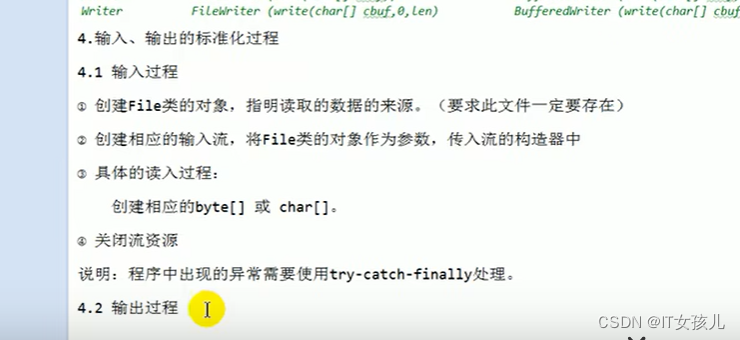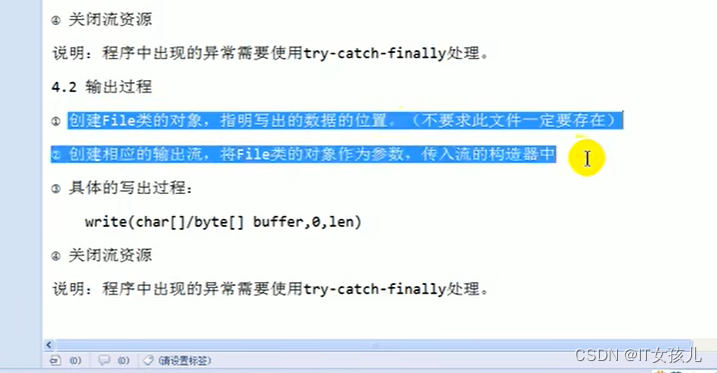上海定制网站建设费用公众号怎么开通
文章目录
- 一、文件读写操作FileReader和FileWriter
- 1.main()
- 2.FileReader
- 1.说明:
- 2.代码案例
- 3.对read()操作升级:使用read的重载方法
- 4.FileWriter的使用
- 1.说明
- 2.代码
- 4.FileReader和FileWriter综合使用
- 二、使用步骤
- 1.引入库
- 二、测试FileInputStream和FileOutputStream的使用
- 1.结论
- 2.使用字节流FileInputStream处理文本文件,可能出现乱码
- 3.实现对图片的复制操作
- 3.指定路径下的文件的复制
- 三、处理流之一:缓冲流的使用
- 1.缓冲流
- 2.作用
- 3.处理流,就是“套接”在已有的流的基础上
- 4.实现非文本文件的复制BufferedInputStream和BufferedOutputStream
- 5.实现文件复制的方法BufferedInputStream和BufferedOutputStream
- 6.使用BufferedReader和BufferedWriter实现文本文件的复制
- 四、处理流之二:转换流的使用
- 1.概念:
- 2.作用
- 3.InputStreamReader
- 4.InputStreamReader和OutputStreamWriter
- 五、流的分类以及流的体系结构
- 六、输入、输出的标准化过程
- 1.输入
- 2.输出
提示:以下是本篇文章正文内容,下面案例可供参考
一、文件读写操作FileReader和FileWriter
1.main()
public static void main(String[] args) {File file = new File("hello.txt"); //相较于当前工程System.out.println(file.getAbsolutePath());File file1 = new File("day04\\hello.txt");System.out.println(file.getAbsolutePath());}
2.FileReader
1.说明:
1.将hello.txt文件内容读入到程序中,并输出到控制台4
2…read()的处理,返回读入的一个字符,如果达到文件末尾,返回-1
3.异常的处理:为了保证流资源一定可以执行关闭操作,需要使用try-catch-finally处理
4.读入的文件一定要存在,否则就会报FileNotFoundException.
2.代码案例
public void testFileReader() {FileReader fr = null;try{//1.实例化File类的对象,指明要操作的文件File file = new File("hello.txt"); //相较于当前Module//System.out.println(file.getAbsolutePath());//2.提供具体的流fr = new FileReader(file);//3.数据的读入//read():返回读入的一个字符。如果到达文件末尾,返回-1.
// 方式一:
// int data = fr.read();
// while(data != -1){
// System.out.print((char)data);
// data = fr.read();
// }//方式二: 语法上针对于方式一的修改int data;while((data = fr.read())!=-1){System.out.println((char)data);}}catch(IOException e){e.printStackTrace();}finally {//4.流的关闭操作try{if(fr!=null)fr.close();}catch(IOException e){e.printStackTrace();}}}
3.对read()操作升级:使用read的重载方法
public void testFileReader1() {FileReader fr = null;try{//1.File类的实例化File file = new File("hello.txt");//2.FileReader流的实例化fr = new FileReader(file);//3.读入的操作//read(char[] cbuf) :返回每次读入到cbuf数组中的字符的个数。//如果达到文件末尾,返回-1。char[] cbuf = new char[5];int len;while((len = fr.read(cbuf))!=-1){//错误的写法
// for(int i = 0;i < cbuf.length;i++){
// System.out.print(cbuf[i]);
// }//方式一:
// for (int i = 0; i < len; i++) {
// System.out.print(cbuf[i]);
//
// }//方式二:错误!
// String str = new String(cbuf);
// System.out.println(str);//正确String str = new String(cbuf,0,len);System.out.print(str);}}catch(IOException e){e.printStackTrace();}finally {//4.流的关闭操作try{if(fr!=null)fr.close();}catch(IOException e){e.printStackTrace();}}}
4.FileWriter的使用
1.说明
1.从内存中写出数据到硬盘的文件里。
2.输出操作,对应的File可以不存在的,并不会报异常
3.File对应的硬盘中的文件如果不存在,在输出的过程中,会自动创建此文件
4.File对应的硬盘中的文件如果存在,
//如果流使用的构造器是: FileWriter(file,false)/(FileWriter(file)):对原有文件的覆盖
//如果流使用的构造器是:FileWriter(file,true):不会对原有文件覆盖,而是追加。
2.代码
public void testFileWriter() {FileWriter fw = null;try{//1.提供File类的对象,指明写出到的文件File file = new File("hello1.txt");//2.提供FileWriter的对象,用于数据的写出fw = new FileWriter(file,true);//3.写出的操作fw.write("I have a dream!\n");fw.write("you need to have a dream!");}catch(IOException e){e.printStackTrace();}finally {//4.流的关闭操作try{if(fw!=null)fw.close();}catch(IOException e){e.printStackTrace();}}}
4.FileReader和FileWriter综合使用
public void testFileReaderFileWriter(){FileReader fr = null;FileWriter fw = null;try{//1.创建File类的对象,指明读入和写出的文件File srcFile = new File("hello.txt");File destFile = new File("hello2.txt");//不能使用字符流来处理图片等字节数据
// File srcFile = new File("111.jpg");
// File destFile = new File("2.jpg");//2.创建输入流和输出流的对象fr = new FileReader(srcFile);fw = new FileWriter(destFile);//3.数据的读入和写出操作char[] cbuf = new char[5];int len;//记录每次读入到cbuf数组中的字符的个数while((len = fr.read(cbuf))!= -1){//每次写出len个字符fw.write(cbuf,0,len);}}catch (IOException e){e.printStackTrace();}finally {//4.关闭数据流try{if(fw!=null)fw.close();}catch (IOException e){e.printStackTrace();}finally {try{if(fr!=null)fr.close();}catch(IOException e){e.printStackTrace();}}}}
二、使用步骤
1.引入库
代码如下(示例):
import numpy as np
import pandas as pd
import matplotlib.pyplot as plt
import seaborn as sns
import warnings
warnings.filterwarnings('ignore')
import ssl
ssl._create_default_https_context = ssl._create_unverified_context
二、测试FileInputStream和FileOutputStream的使用
1.结论
1.对于文本文件(.txt,.java,.c,.cpp),使用字符流处理
2.对于非文本文件(.jpg,.mp3,.mp4,.avi.doc,.ppt,…),使用字节流处理
2.使用字节流FileInputStream处理文本文件,可能出现乱码
public void testFileInputStream(){FileInputStream fis = null;try{//1.造文件File file = new File("hello.txt");//2.造流fis = new FileInputStream(file);//3.读数据byte[] buffer = new byte[5];int len; //记录每次读取的字节的个数while((len = fis.read(buffer)) != -1){String str = new String(buffer,0,len);System.out.println(str);}}catch(IOException e){e.printStackTrace();}finally {try{if(fis != null){fis.close();}}catch(IOException e){e.printStackTrace();}}}
3.实现对图片的复制操作
public void testFileInputOutputStream(){FileInputStream fis = null;FileOutputStream fos = null;try{File srcFile = new File("111.jpg");File destFile = new File("2.jpg");fis = new FileInputStream(srcFile);fos = new FileOutputStream(destFile);//复制的过程byte[] buffer = new byte[5];int len;while((len = fis.read(buffer))!= -1){fos.write(buffer,0,len);}}catch (IOException e){e.printStackTrace();}finally {if(fos != null){try{fos.close();}catch(IOException e){e.printStackTrace();}}}}
3.指定路径下的文件的复制
public void copyFile(String srcPath,String destPath){FileInputStream fis = null;FileOutputStream fos = null;try{File srcFile = new File(srcPath);File destFile = new File(destPath);fis = new FileInputStream(srcFile);fos = new FileOutputStream(destFile);//复制的过程byte[] buffer = new byte[1024];int len;while((len = fis.read(buffer))!= -1){fos.write(buffer,0,len);}}catch (IOException e){e.printStackTrace();}finally {if(fos != null){try{fos.close();}catch(IOException e){e.printStackTrace();}}}}@Testpublic void testCopyFile(){long start = System.currentTimeMillis();String srcPath = "C:\\Users\\asus\\Desktop\\1.mp4";String destPath = "C:\\Users\\asus\\Desktop\\2.mp4";copyFile(srcPath,destPath);long end = System.currentTimeMillis();System.out.println("复制操作花费的时间为:"+(end-start));}
三、处理流之一:缓冲流的使用
1.缓冲流
BufferedInputStream
BufferedOutputStream
BufferedReader
BufferedWriter
2.作用
提供流的读取、写入的速度
提高读写速度的原因,内部提供了一个缓冲区
3.处理流,就是“套接”在已有的流的基础上
4.实现非文本文件的复制BufferedInputStream和BufferedOutputStream
public void BufferedStreamTest(){BufferedInputStream bis = null;BufferedOutputStream bos = null;try{//1.造文件File srcFile = new File("111.jpg");File destFile = new File("222.jpg");//2.造流//2.1 造节点流FileInputStream fis = new FileInputStream(srcFile);FileOutputStream fos = new FileOutputStream(destFile);//2.2造缓冲流bis = new BufferedInputStream(fis);bos = new BufferedOutputStream(fos);//3.复制的细节:读取、写入byte[] buffer = new byte[10];int len;while((len = bis.read(buffer))!=-1){bos.write(buffer,0,len);}}catch (IOException e){e.printStackTrace();}finally {//4.资源关闭//要求:先关闭外层的流,再关闭内层的流//说明:关闭外层流的同时,内层流也会自动的进行关闭。//关于内层流的关闭,我们可以省略if(bos!= null){try{bos.close();}catch (IOException e){e.printStackTrace();}}if(bis!=null){try{bis.close();}catch(IOException e){e.printStackTrace();}}}}
5.实现文件复制的方法BufferedInputStream和BufferedOutputStream
public void copyFileWithBufferd(String srcPath,String destPath){BufferedInputStream bis = null;BufferedOutputStream bos = null;try{//1.造文件File srcFile = new File(srcPath);File destFile = new File(destPath);//2.造流//2.1 造节点流FileInputStream fis = new FileInputStream(srcFile);FileOutputStream fos = new FileOutputStream(destFile);//2.2造缓冲流bis = new BufferedInputStream(fis);bos = new BufferedOutputStream(fos);//3.复制的细节:读取、写入byte[] buffer = new byte[1024];int len;while((len = bis.read(buffer))!=-1){bos.write(buffer,0,len);// bos.flush();//刷新缓冲流}}catch (IOException e){e.printStackTrace();}finally {//4.资源关闭//要求:先关闭外层的流,再关闭内层的流//说明:关闭外层流的同时,内层流也会自动的进行关闭。//关于内层流的关闭,我们可以省略if(bos!= null){try{bos.close();}catch (IOException e){e.printStackTrace();}}if(bis!=null){try{bis.close();}catch(IOException e){e.printStackTrace();}}}}
public void testCopyFileWithBuffered(){long start = System.currentTimeMillis();String srcPath = "C:\\Users\\asus\\Desktop\\1.mp4";String destPath = "C:\\Users\\asus\\Desktop\\3.mp4";copyFileWithBufferd(srcPath,destPath);long end = System.currentTimeMillis();System.out.println("复制操作花费的时间为:"+(end-start));}
6.使用BufferedReader和BufferedWriter实现文本文件的复制
public void testBufferedReaderBufferedWriter(){BufferedReader br = null;BufferedWriter bw = null;try{//1.创建文件和相应的流br = new BufferedReader(new FileReader(new File("hello.txt")));bw = new BufferedWriter(new FileWriter(new File("hello3.txt")));//2.读写操作//方式一:
// char[] cbuf = new char[1024];
// int len;
// while((len = br.read(cbuf))!=-1){
// bw.write(cbuf,0,len);
bw.flush();
// }//方式二:String data;while((data = br.readLine())!=null){//方法一:
// bw.write(data+"\n"); //data不包含换行符//方法二:bw.write(data);bw.newLine(); //提供换行的操作}}catch(IOException e){e.printStackTrace();}finally {//3.关闭资源try{if(bw!=null)bw.close();}catch (IOException e){e.printStackTrace();}try{if(br!=null)br.close();}catch (IOException e){e.printStackTrace();}}}
四、处理流之二:转换流的使用
1.概念:
转换流:属于字符流
InputstreamReader: 将一个字节的输入流转换为字符的输入流Outputstreamwriter: 将一个字符的输出流转换为字节的输出流
2.作用
提供字节流与字符流之间的转换
3.InputStreamReader
//此时处理异常的话,仍然应该使用try-catch-finally//InputStreamReader的使用,实现字节的输入流到字符的输入流的转换@Testpublic void test1() throws IOException {FileInputStream fis = new FileInputStream("hello.txt");
// InputStreamReader isr = new InputStreamReader(fis);//使用系统默认的字符集//参数2指明了字符集,具体使用哪个字符集,取决于文件hello.txt保存时使用的字符集InputStreamReader isr = new InputStreamReader(fis,"UTF-8");char [] cbuf = new char[20];int len;while((len = isr.read(cbuf))!=-1){String str = new String(cbuf,0,len);System.out.print(str);}isr.close();}
4.InputStreamReader和OutputStreamWriter
//此时处理异常的话,仍然应该使用try-catch-finally//综合使用InputStreamReader和OutputStreamWriter@Testpublic void test2() throws IOException {//1.造文件 造流File file1 = new File("hello.txt");File file2 = new File("hello_gbk.txt");FileInputStream fis = new FileInputStream(file1);FileOutputStream fos = new FileOutputStream(file2);InputStreamReader isr = new InputStreamReader(fis,"utf-8");OutputStreamWriter osw = new OutputStreamWriter(fos,"gbk");//读写过程char [] cbuf = new char[20];int len;while((len = isr.read(cbuf))!=-1){osw.write(cbuf,0,len);}//3.关闭资源isr.close();osw.close();}
五、流的分类以及流的体系结构

六、输入、输出的标准化过程
1.输入

2.输出

